Chris Baty's Blog, page 87
December 7, 2018
Project For Awesome 2018
Project for Awesome has begun! If you want to help support NaNoWriMo, it’s an easy 5-step process:
1. Be awesome.
2. Click through to the “NaNoWriMo” videos on the Project for Awesome site.
3. Click on each video about NaNoWriMo.
4. Click the “I’m not a robot!” box, then click the big VOTE button on each video.
5. Share this post and encourage your friends to vote, too.
And… that’s it! If you’ve always wanted to support NaNoWriMo but haven’t had the resources to donate, all this will take is 30 seconds of your time and a few clicks of the ol’ mouse. In previous years, the support of P4A (and users like you) has helped NaNoWriMo continue encouraging writers around the world!
December 4, 2018
NaNoWriMo 2018 may be over, but we’re still thinking about what...

NaNoWriMo 2018 may be over, but we’re still thinking about what we’ve learned along the way.
During last week’s Virtual Write-In, we asked NaNo participants about the lessons they’ve learned over the course of November—about writing, community, and themselves—and compiled them into a handy infographic for you.
What did you learn during NaNoWriMo 2018?
December 3, 2018
Fell Short of 50K? Give Yourself Some Credit — Then Keep Going!

Another November has come and gone; while some of you are celebrating the completion of 50,000 words, some of you didn’t make it quite as far as you’d have liked. Today, writer Adrianne DeWeese shares some words of encouragement about continuing to write, whether or not you met your word-count goal this year:
November has always been a month of great promise for me. It’s the eve of one of the busiest months of the year, before the calendar page turns for the final time that year. It is a month of thanks, of renewed hope. As one of my all-time favorite bands, Jimmy Eat World, summarized it so eloquently in their 2004 album title track “Futures”:
I always believed in futures
I hope for better
In November.
I held onto that same sense of promise and optimism this year going into my first-ever NaNoWriMo experience. Unfortunately, a brief bout of seasonal sinus issues found me bedridden during my spare time for two weeks.
It was certainly frustrating, as I was hell-bent on reaching that 1,667 minimum daily word count. I knew I had to take care of myself, though, so I asked myself what the alternatives were: I did what I could to continue chipping away at my bucket-list goal of one day writing a book.
I continued to write by hand. I checked out several amazing books about writing from my local public library: The Thorn Necklace by Francesca Lia Block; and Elizabeth Sims’ You’ve Got a Book in You: A Stress-Free Guide to Writing the Book of Your Dreams.
I also rewrote the outline to my novel twice (third time’s a charm!), while using the two earlier iterations as the backbone for what I feel is going to make a solid first draft. Most importantly, I was gentle with myself in what I could achieve, even if it were just 200 words on the screen – and I kept my eye on December.
December also happens to be my birthday, and as a gift to myself for turning 33, I’ve vowed to keep up an unofficial NaNoWriMo effort throughout the month.
Perhaps you, too, need to keep writing in December to reach the “Now What?” months of January and February. Here are two tips I’m going to use for the upcoming 31 days:
#1: Visualize a time in your life when you overcame a challenge.Writing a book often seems impossible. But you and I both, my dear reader, have been here before. Think of a time in your life where something once seemed out of reach, but you were able to accomplish it anyway.
For me, I think about my competitive running days in high school. I visualize the times when I didn’t think I had the strength or momentum to finish the second mile of the race. Then, I remembered that I already had – many times – when I ran six, seven, eight miles in a row at practices. Writing is no different: Put in the time and the work, and the output will follow.
My writing time is limited to very specific portions of my days, typically two to three hours in the evening. For me, I actually prefer this structure, as I should ideally be able to focus in such a short span and get the work done. However, November often found me wandering over to Twitter for “check-ins” or answering personal emails.
For December, I plan to set a daily intention before my writing begins. Also, if I feel the Internet is going to pose too much of a distraction, I also can opt to shut my laptop altogether for several days a week and write longhand, a practice that Sims recommends in her book. (NaNoWriMo also has a great new video related to battling distractions.)
Above all else, be patient and gentle with yourself if you didn’t hit 50K in November. December – a whole new month, with an extra day! – awaits you. You can – and you will – begin again. Returning to Jimmy Eat World, and the words of “Futures”: My darling, what matters is what hasn’t been.

Adrianne DeWeese is a nonprofit fundraising professional who writes and reads as much as possible in her spare time. A former newspaper reporter, she earned her Master of Public Administration from the University of Missouri-Kansas City in May 2018. Her first novel, Be For, is a work in progress, exploring themes of self-awareness, the convenience of technology, and what to do once you finally have the answers to life. She enjoys tweeting about writing and reading, the nonprofit community, space, and much more @AdrianneDeWeese.
December 1, 2018
30 Covers, 30 Days 2018: Wrap-Up!

That’s a wrap on another NaNoWriMo, which means it’s the end of another year’s 30 Covers, 30 Days series! Whether you wrote fifty words or fifty thousand, you got your stories onto the page! So pat yourself on the back. I’ll wait here.
Excellent! I want to talk a little bit about this project; as this was my second year coordinating the series, I got to read all of your nearly three thousand synopses, and every one of them brought something unique to the table. I’m seriously blown away by how amazing your novels – and the covers they inspired – have turned out to be.
Before I get to the fast facts about this year’s series, I need to extend a few words of thanks.
First, immense thanks as always to the amazing Debbie Millman, for facilitating this project every year, gathering all these fantastic designers in one place, and for designing a cover herself! Thanks for all your help getting this project off the ground, and answering all my questions along the way.
This wouldn’t be possible without all the designers who volunteered to make covers this year (and in years past). You made some stunning covers, on a short deadline, for free, frequently ahead of schedule, and with enthusiasm every day. Thanks for your patience and quick responses to all of my emails, and for making covers that thirty authors will cherish, and that amazed, thrilled, puzzled, and inspired writers on the blog, forums, and beyond all month long.
If you received a cover, or just felt inspired by one, please take a moment to let these designers know how cool they are; the complete list of designers, including links to their websites and social media, is available at the end of the post.
If you want to leave some feedback, there’s a form available! This helps us tweak and tune up the project each year.
Finally, thank you to all of you who took on the challenge, submitted synopses throughout October and November, and for keeping up with the blog and forum posts every day.
—
As with every year, of course, November only has thirty short days – and with them, only thirty lucky writers selected for each edition of the project via our proprietary, time-bending, squirrel-powered synopsis algorithm.
This year, we had winners from all around the world, including from Iceland, Nigeria, and Peru. And, as novels from Young Writers made up about a quarter of submissions, there were set to be seven YWP covers. Alas, a couple of them fell through a hole in time and space and there ended up being only five; next year will have the complete set. There was also a wide range of genres represented:
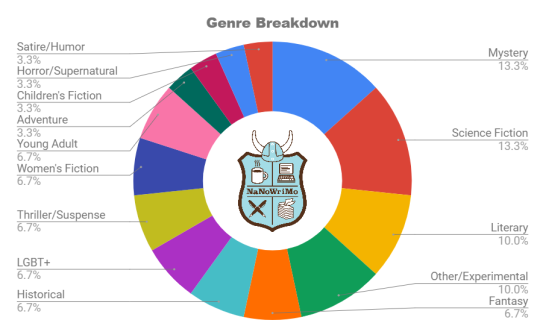
We also used the keywords and tags from thousands of submissions to create a word tree!

Please give another round of applause to the designers who contributed their time and effort to this awesome project!
John Hamilton designed Enemy MusicKatie Manos designed The Ghosts of Miller Manor
Jesse Hernandez designed Apologize
Michelle Hobbs designed Autumn’s Blessing
Michael Braley designed The White Darkness
Kelly Knaga designed No Results Found
Alberto Rigau designed Shadow of Twilight
Kevin Perry designed Red Riding, P.I.
Henry Sene Yee designed The Killing Thing
Cookie Redding designed Sunsets and Tea
David Hisaya Asari designed We Could Be Heroes
Mark Pagano designed Dragon Kingdom & The Wishing Stone
Don Hollis designed Perspicuus
Richard Ljoenes designed The Girl and the Guardians
Alexandra Alcantara designed The Island
Josh Ege designed Trapped
Val Head designed Cracking Up
Traci Larson designed Monroe & Patsy: A Few Times Too Many
Eva Crawford designed Nursing Holmes
Frances Yllana designed Albion Grove
Courtney Glancy designed To Stand Tall Amongst the Stars
Christopher Simmons designed Unprompted
Tan Le designed Windycrest
Debbie Millman designed The Circle
Roshanak Keyghobadi designed Balaton
Nick Fierro designed Emu
Wesley Sueker designed Combat Mind
Ksenya Samarskaya designed The Author
Adriane Stark designed Bianca, It’s Complicated!
Jina Anne designed The Sorcerer’s Maid
It’s been a blast helping coordinate 30 Covers, 30 Days once more. I’m looking forward to seeing next year’s covers!
-Nick Fierro, Editorial & Programs Intern
November 30, 2018
Congratulations, NaNoWriMo Writers!Whether you reached 50K this...
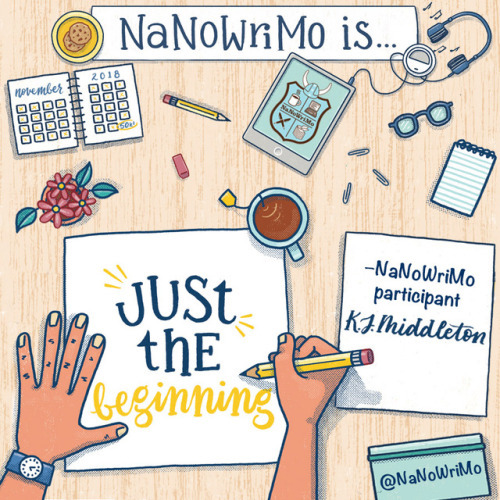
Congratulations, NaNoWriMo Writers!
Whether you reached 50K this November or not, one of the most important things that NaNoWriMo can help you do is jumpstart a creative habit. It doesn’t matter if it takes you one month or ten years to finish a draft; the fact that you’ve taken the time to tell your story makes you a winner in our eyes. Join us in January and February as we take you through the revision, editing, and publishing process during our “I Wrote a Novel… Now What?” months!
“NaNoWriMo is… just the beginning.”
–NaNoWriMo participant K. J. Middleton
30 Covers, 30 Days 2018: Day Thirty
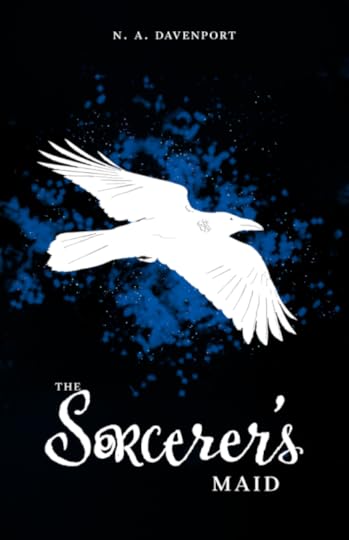
Every November, during National Novel Writing Month, thirty professional designers volunteer to create book cover art inspired by novels being written by aspiring authors from around the globe. Why? To encourage new, diverse voices, and help build a more creative world.
30 Covers, 30 Days is presented in partnership with designer and author Debbie Millman. Read more about these NaNoWriMo 2018 novels-in-progress, and the cover designers, below.
The Sorcerer’s MaidA Fantasy novel being written this November by NaNo participant N.A. Davenport in the United States.
Melody Brooks is a poor college student who takes a job as housekeeper. But the eccentric old man she works for believes that he is a medieval sorcerer. She struggles working in an old house without electricity, cooking over a fire, and avoiding the mischief from his pet raven. Then things change when the old man believes his mortal enemy is closing in, an enemy who doesn’t care how many he kills to draw out the old sorcerer. Melody starts to think that things aren’t quite as they seem.
That’s it for the month! Keep an eye out for our Wrap-Up post, coming tomorrow!
I want to mention there is a Feedback Form open now that will allow you to send in your valuable comments, concerns, suggestions, and more about the 30 Covers, 30 Days program.
Cover Designed by Jina Anne
Jina is a consultant, community builder, and advocate focused on design systems. She organizes Clarity, the first Design Systems conference. She co-authored the Design Systems Handbook, Fancy Form Design, and The Art & Science of CSS. She has been said to be one of the most cheerful goths. You can follow her online @jina.
November 29, 2018
Let Your Novel Simmer and Marinate with Scrivener

Every year, we’re lucky to have great sponsors for our nonprofit events. Now that we’re closing in on the final stretch of November, you may be wondering what to do with your novel after the month is over. Today, Scrivener, a NaNoWriMo sponsor, has some tips for post-NaNo noveling:
Completing the first draft of a novel in one month isn’t work for the faint of heart. Showing up every day to write, muddling through the middle, making your hero or heroine suffer, or just wondering where this little adventure will eventually lead takes perseverance, guts, and a touch of madness.
Now that you’ve reached (or nearly reached) the fifty thousand word mark, you’ve probably decided that you’re ready for the next step: revising your story. But hold on there, bucko, not quite yet. If you want maintain a firm grip on your sanity, please heed this advice: let it simmer and marinate for a month.
Below are tips on how I’ve lassoed the editing process and how I used Scrivener to revise, restructure, and rewrite my NaNoWriMo first draft in five easy steps:
Step one: Give it a rest.By this I mean put it away. Come December 1st, tuck your novel into a virtual drawer. Don’t open it. Don’t attempt to reread or edit the copy. December is crazy enough with end-of-year projects, tying loose ends, the holidays, socializing, and whatnot. Your novel isn’t going anywhere, so take a break. But what about losing that writing momentum? Don’t worry about it. Let the story-telling part of your brain recharge. Trust me, you’ll thank me for it.
Step two: Re-read your story.On January 1st, if you wrote your first draft in Scrivener, open your manuscript. Next, select the draft/manuscript folder that contains all your scenes and go to View—>Scrivenings. This is a robust feature that allows you to view sections of your text either in isolation or as part of the larger work. Now read your story all the way through. Easy now, put down that letter opener and take a deep breath. Remember, first drafts are rarely perfect.
Step three: Write scene synopses.Get out of Scrivenings mode, and reread each scene. Open the Inspector and click on the tab that looks like a notepad. You’ll see on the top pane “Synopsis" and below “Notes”. In Synopsis, summarize the scene in twenty words. Reread the scene; start taking notes on anything that jumps out at you—the good the bad, and the ugly. Do this with every single scene.
Step four: Snapshot your scene.You’ve reached the point when it’s time to delete and revise: but before you begin with the bloodletting, click on the camera icon found in the Inspector, and take a snapshot of the entire scene. Using this feature saves your original text and allows you to go back to it or even restore it. To read more of how snapshots work, please visit this very detailed blog post.
Step five: Kill those darlings.Move paragraphs around. Reconsider different names. Highlight text. Reword sentences. Use stronger verbs. Consider using the Comments feature in the editor and make more notes. Also use Scrivener’s revision mode by going to Format—>Revision Mode. Click on the colored menu command you wish to use for your edits. As you type in new text, it will be automatically colored. Want to strike-through a section? Simply select the word or text you want to cross out by going to Format—>Strikethrough.
Once you’re satisfied with your edits, it’s time to compile the draft as a proof copy so your beta readers can read the entire manuscript and provide feedback. Scrivener has a robust compiling feature that allows you to choose a number of built-in formats including the common industry standard for submitting to agents as well as others that are designed for ebooks. To learn how to compile, Literature and Latte has created four videos that guide you step-by-step through the process. These instructional videos can be found on the website under the section “Getting Your Work Out”.
Last WordsKeep learning about your craft. There are a number of blogs like Writer Unboxed that address editing and revisions; books such as Elizabeth Lyon’s Manuscript Makeover or Sandra Scofield’s The last Draft: A Novelist’s Guide to Revision and Donald Maass’s Writing the Breakout Novel that will help you during this process. Finally, keep your expectations in check. Completing a first draft in one month is extraordinary, but having a ready-to-publish manuscript takes even more time, perseverance, guts, and a touch or madness…
Rebeca Schiller is a freelance writer who also blogs for Literature and Latte. She is currently working on a novel about the Spanish Civil War and the blacklist.
Top photo by Clem Onojeghuo on Unsplash.
30 Covers, 30 Days 2018: Day Twenty-Nine

Every November, during National Novel Writing Month, thirty professional designers volunteer to create book cover art inspired by novels being written by aspiring authors from around the globe. Why? To encourage new, diverse voices, and help build a more creative world.
30 Covers, 30 Days is presented in partnership with designer and author Debbie Millman. Read more about these NaNoWriMo 2018 novels-in-progress, and the cover designers, below.
Bianca: It’s Complicated!A Women’s Fiction novel being written this November by NaNo participant Erryn “Writer_Dye” Howard in the United States.
Bianca is ushering in her 30th birthday alone, at a bar, with her favorite drink, a purple margarita. For many, turning 30 is a rite of passage into the true, real world of adulthood but for Bianca, it is quite the opposite. Age 30 is a solemn reminder of all the plans in life she made but never fulfilled, a visual reminder of her “Things To Do By 30” checklist that hasn’t accrued many checks yet. When it comes to following her innate passion in life, understanding who she is as a woman (even if it doesn’t adhere to societal norms), and of course, finding a prince among paupers…let’s just say “It’s Complicated!”
“Bianca, It’s Complicated!” is a novel that follows one young woman’s journey into the next phase of womanhood, but not before revisiting all the milestones and pitfalls that has brought her to where she is today. Will she be able to face her past and embrace her flaws in order to claim her crown?
Cover designer Adriane Stark shared these sketches and notes about the design process:
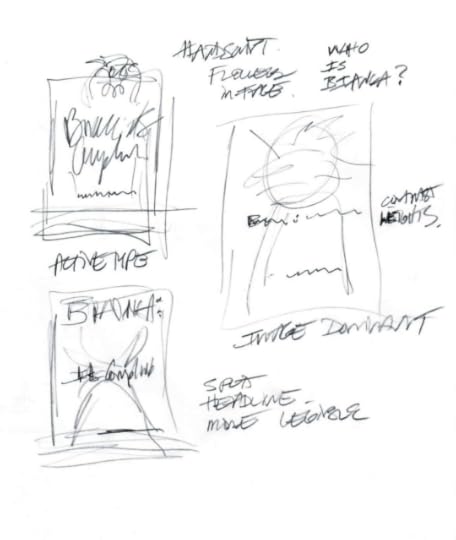
I was honored to take part in the NaNoWriMo program. The provocative title drew me to select this novel. Typically I work on covers with a completed manuscript, so having only a synopsis was challenging. A cover can’t tell the whole story, obviously, but it needs to convey enough visual clues to grab your attention and want more. When starting a cover I always ask myself a lot of questions from the mindset of the reader. I thought a lot about “who is this woman”? The synopsis mentions her sitting alone at a bar on her 30th birthday with a purple margarita, but that would have been too obvious a direction. She’s 30, not 90, far too young to feel her life is over. A purple martini in a glass or a bar scene would have been way too easy and simple a design solution. I wanted an image that hit the right note without looking too forlorn. This image is engaging and conveys that things aren’t quite right but not hopeless with a touch of humor.
The title which drew me to this book initially turned out to be COMPLICATED to work with. What does it mean? Is life complicated or is Bianca or both? That colon! In earlier layouts I had the title on one line but it began to read as “Bianca is Complicated”, possibly too confusing. I also felt it was important to establish the main character. By breaking up the title and giving each element its own importance, the title became stronger and more balanced visually, a great quick read. This type solution appears as a note of kindness and love from a friend, advice and support through life’s ups and downs, something we can all relate to.
Stay tuned for new covers every day of the month!
I want to mention there is a Feedback Form open now that will allow you to send in your valuable comments, concerns, suggestions, and more about the 30 Covers, 30 Days program.
Cover Designed by Adriane Stark
Adriane Stark is the founder of StarkWork. As
Creative Director, she creates strategic design communications for a broad
spectrum of global publishing, service, financial, entertainment and
retail corporations. Her work has been nationally recognized in various
areas of the field by the American Institute of Graphic Arts, The Art
Director’s Club, Graphis, The Society of Publication Designers, and The Type
Directors Club. StarkWork is honored to have its work selected for the
permanent collection of The Cooper Hewitt Design Museum. Adriane is a
graduate of Parsons School of Design and attended the Columbia University
Masters program in Strategic Communications. She is a former instructor at the
School of Visual Arts in New York City. Connect with StarkWork online at
Instagram @StarkWork, StarkWork.com and on
StarkWork’s Facebook page.
November 28, 2018
“The books I wanted to read didn’t exist.” —Min Jin LeeOur...
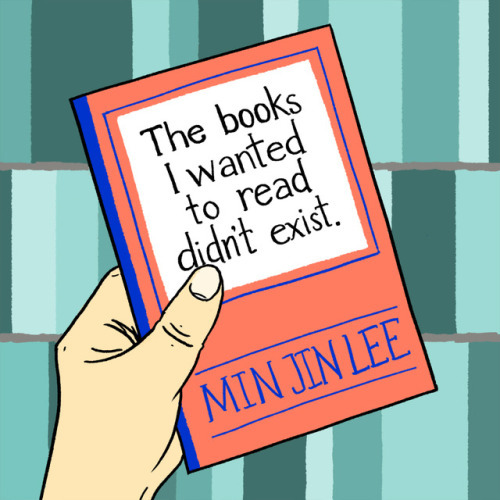
“The books I wanted to read didn’t exist.” —Min Jin Lee
Our amazingly multi-talented Customer Service Captain, Wesley Sueker, has illustrated quotes from this year’s Pep Talks! Check out Wesley’s other work on DeviantArt, and read the rest of Min Jin’s pep talk here.
What to Do With Your Manuscript in December

Every year, we’re lucky to have great sponsors for our nonprofit events. Now that we’re closing in on the final stretch of November, you may be wondering what to do with your novel after the month is over. Today, Reedsy, a NaNoWriMo sponsor, has some tips for post-NaNo noveling:
As November draws to a close and your word count finally reaches that elusive 50,000 mark, you might be thinking about what comes next. Perhaps you’ve heard of the great publishing success stories that have come out of NaNoWriMo, and you hope to be one of them.
The cold hard truth is that to become one of those success stories, you need to do a lot more than finish November with a manuscript. And while you should rightfully be proud of your hard-earned words, there’s still a long road ahead to getting them published.
Luckily, you don’t have to go through it all on your own! Here are a few tips to help you figure out what yo do with your manuscript after November has come to an end.
Step 1: Wait.Yes, you heard correctly—this is the time to wait.
You just spent a whole month immersed in your novel’s world, so the best thing to do is to step back until you stop obsessing over it all day, every day. This might take a few weeks or even a few months, but it’s important not to go back to your story too soon after you’re done writing it. Taking time away will give you the chance to approach your manuscript with fresh eyes, which will help with the next few steps.
But just because you’re not working on your NaNoWriMo project doesn’t mean you should let your writing momentum fall apart! Just like a sprinter wouldn’t stop dead cold after crossing the finish line, you shouldn’t throw away your pen come December 1st. If you are not sure what to write about and are in need of inspiration (you just wrote a full story, after all), try turning to writing prompts and grind out some shorts—you don’t know where your next idea might come from.
Step 2: Re-read your manuscript.Once you are ready to approach your text again, don’t go in expecting to do heavy revisions and edits from the get-go. Instead, start off by re-reading your manuscript (out loud, if you can) and reacquaint yourself from a different perspective.
Sure, you wrote it, but after being away from it for several weeks—or at least a few days—you’ll see it in a brand new light, and seeing it after some time away can be a revelatory experience.
Step 3: Do a story review and rewrite.After re-reading your manuscript, it’s time to dive in with a critical eye and start the story review process. As you read through your manuscript, ask yourself the following questions:
Is there a central idea or theme?Are there unresolved situations?Are the characters sufficiently developed?Is there a concrete plot?Do you have enough worldbuilding?Is there any character or plot point that doesn’t add anything to the story?Is there a satisfying resolution? And if not, is that what you want?At this point, you might cut away entire subplots or characters, introduce new ones, and switch the order of scenes until you have a cohesive narrative that works on a macro level. Your draft can (and most likely will) change a lot during this process, but that’s the point. Many bestsellers have actually been completely re-written during the revision stages—and you shouldn’t skimp on that either.
Step 4: Self-edit the copy.Once you’re done reviewing your story, go in and treat yourself to a round of copy-editing (you shouldn’t get too caught up with line-editing before this stage). This will help you improve the technical parts of your manuscript and iron out your writing tics (think: excessive adverbs and overused turns of phrase).
Don’t try to fix everything at once: address one issue at a time. Do a pass where you focus only on looking for long, winding sentences and another where you look for ways to control your pace.
Editing tools such as Grammarly and ProWritingAid can be a great help in highlighting these problem areas.
Step 5: Proofread.After you’re done with all the necessary self-edits, go back through your manuscript and proofread it. Try reading through it using a highlighter and looking out for any typos, awkward phrasing, or glaring inconsistencies that you might have missed during revisions and rewrites.
Reading out loud is another great way to go through your manuscript. This way you can often find mistakes and weird wording that you could have missed otherwise.
Step 6: Share it.No, it’s not time to share it with professional proofreaders and editors just yet—but it is time to share it with someone whose opinion you trust. Try showing your manuscript to a close friend or family member who you know will provide an honest opinion on your writing, plot, and characters.
If you don’t want to show it to anyone you know (it can be pretty intimidating), try looking for a writing community that fits your needs, or a beta reader who will be able to provide a truly unbiased opinion that friends and family typically cannot.
Step 7: Rinse and repeat.After getting an honest opinion on your manuscript, take note of their comments, especially their criticism, and repeat the whole process—chiseling away at the marble slab that is your novel. It may take many more months or even years before you’re truly ready to submit it to an industry professional for review, or query an agent. But don’t be discouraged—it’s completely normal to revise and rewrite.
Step 8: Look for an editor.Now that you’ve done a story review, self-edited your manuscript, proofread it, got an honest third-party opinion, and repeated the process, it’s time to work with a professional. An experienced editor will help you grow as a writer and learn about the craft—very often, more so than if you were to take a writing class. But there are a few things to keep in mind when deciding who to contact.
What does your manuscript need right now? Are you struggling with big picture problems? Try a developmental editor? Need help improving the language? Hire a copy editorDoes the editor have experience in your genre?What style of criticism do you prefer: gentle and encouraging, or brutally honest?Waiting to work with a professional until you’ve gone through your manuscript a few times will guarantee you a much better editing experience and will also maximize your bang-for-buck.
Step 9: Keep Writing.Many now-successful authors didn’t write anything useful on their first, second, or even third run—but they kept on going and eventually found the perfect idea that took them to publication. If you find yourself at this point, use the skills you learned from writing a manuscript in a month and keep on trying.
Preparing a manuscript for publishing might seem overwhelming, but going through this process carefully and thoroughly can help you take your novel to the next level and greatly improve your chances of eventually getting published. Just remember: don’t despair, and keep on writing.
Ricardo Fayet is a co-founder of Reedsy, an online marketplace connecting authors with industry’s best editors, designers and book marketers.
Top photo by Trent Erwin on Unsplash.
Chris Baty's Blog
- Chris Baty's profile
- 63 followers



